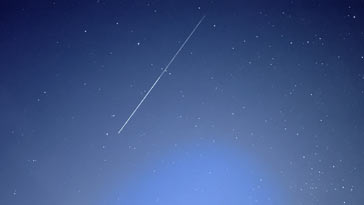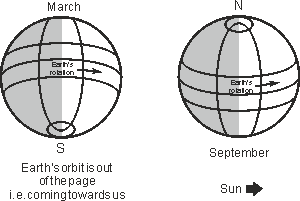Meteors & Meteor Showers Explained
Over the course of a year, the Earth passes trough several areas of space "dust" which give rise to displays of meteor showers at specific dates.
Home » Antennas & Propagation » this page
Meteor scatter tutorial includes:
Meteor burst communications
Meteor types & showers
Meteor trails & radio signals
Propagation & frequencies
Although it may appear that meteors would all be the same as they all come from space, they can be categorised in different ways.
Although not always true, the types of meteor trail that the different types tend to make is different and this means that the radio propagation characteristics are different.

Meteor types
It is possible to split the meteors entering the atmosphere into two categories. One category is those that are associated with meteor showers at particular times of the year. The other is the meteors that enter the atmosphere all the time that are known as sporadic meteors.
- Meteor showers: It found that at specific times during the year, the number of meteors entering the atmosphere rises significantly as a result of meteor showers. They occur as the Earth's path passes through debris in its orbit around the Sun. Often these have been traced back to the passage of a comet. For some of the larger showers, the number of visible trails rise significantly allowing the casual observer to see a worthwhile of trails in an evening. Of the meteor showers, the Perseids shower in August is probably the best, and the Quadrantids in January also produces a large number of trails.
Shower meteors are characterised by what is termed their radiant. This is the point in the sky from which they appear to originate. The radiant is usually identified by the name of the constellation or major star in the area of the sky from which they appear to come, and this name is usually given to the shower itself. Apart from the main showers, there are hundreds and possibly thousands of smaller showers that have been recorded, often by amateur observers. - Sporadic Meteors: The greatest number of meteors entering the atmosphere arises from sporadic meteors. These are the space debris that exists within the universe and in our solar system. The majority of this debris arises from the vast amounts of material that is thrown out by the Sun into the universe. Unlike the shower meteors they enter in all directions and they do not have a radiant.
Major meteor showers & dates
Meteor showers occur regularly each year as the Earth passes through each stream of space debris.
A table of the major meteor showers is given below:
| Major Meteor Showers& their dates |
|||
|---|---|---|---|
| Shower name | Start date | Peak date | End date |
| Quadrantids | 1 January | 3 January | 6 January |
| April Lyrids | 19 April | 21 April | 24 April |
| Eta Aquarids | 1 May | 4 May | 7 May |
| June Lyrids | 10 June | 15 June | 21 June |
| Ophiuchids | 17 June | 20 June | 26 June |
| Capricornids | 10 July | 26 July | 15 August |
| Delta Aquarids | 15 July | 27 July | 15 August |
| Pisces Australids | 16 July | 2 August | 25 August |
| Alpha Capricornids | 15 July | 2 August | 25 August |
| Iota Aquarids | 15 July | 6 August | 25 August |
| Perseids | 25 July | 12 August | 18 August |
| Orionids | 16 October | 21 October | 26 October |
| Taurids | 20 October | 4 November | 25 November |
| Cepheids | 7 November | 9 November | 11 November |
| Leonids | 15 November | 17 November | 19 November |
| Geminids | 7 December | 14 December | 15 December |
| Ursids | 17 December | 22 December | 24 December |
Meteor scatter changes over the day
It is found that after meteor showers have been discounted, the density of space debris in the solar system is broadly constant, although there are some variations as described later.
Despite this the rate at which meteors enter the atmosphere changes considerably over the course of a day. This results from effects associated with the rotation of the Earth.
This occurs because the meteors are "swept up" as the Earth's atmosphere rotates into the sunrise, where the atmosphere forms the leading edge as the Earth moves round the Sun. and falls away as it rotates into the sunset.
Similarly it falls away at sunset where the atmosphere forms the trailing edge. The same effect can be seen as an automobile is driven in rain, and the rain drops hit the front windscreen but very few hit the rear window.
This effect means that the minimum number of sporadic meteors enter the atmosphere at around 6pm, and the maximum number at around 6 am.
Also, the ratio between the maximum and minimum is around 4:1, but the exact figure is dependent upon a number of factors including the latitude at which the measurement is taken being a maximum at the equator and a minimum at the poles.

Seasonal variations of sporadic meteors
There are other factors that affect the numbers of meteors entering the atmosphere. One is the season and there are two reasons to which this can be attributed:
Space debris is not uniform The first is that the density of space debris around the Earth's orbit is not uniform. The density is higher in the areas of the orbit that the earth passes through in June, July and August.
Declination of Earth's axis The other reason is related to declination of the Earth's axis. There is a 22.5 degree tilt of the polar axis relative to the sun that gives rise to the different seasons, and as well as the seasonal variation in meteor rate. Those areas at right angles to the direction of travel will receive the most meteors, whereas those at a greater angle receive less.

Meteor scatter / meteor burst communications seasonal variations
These two effects have combine differently dependent upon the hemisphere. The maximum to minimum variation is accentuated in the northern hemisphere where the two effects add together. However it is minimised in the southern hemisphere where the two effects tend to cancel each other.
It is also found that the number of meteors entering the atmosphere changes with the sunspot cycle. The number of meteors rises to a peak around the trough of the sunspot cycle.
 Written by Ian Poole .
Written by Ian Poole .
Experienced electronics engineer and author.
More Antenna & Propagation Topics:
EM waves
Radio propagation
Ionospheric propagation
Ground wave
Meteor scatter
Tropospheric propagation
Antenna basics
Cubical quad
Dipole
Discone
Ferrite rod
Log periodic antenna
Parabolic reflector antenna
Phased array antennas
Vertical antennas
Yagi
Antenna grounding
Installation guidelines
TV antennas
Coax cable
Waveguide
VSWR
Antenna baluns
MIMO
Return to Antennas & Propagation menu . . .



